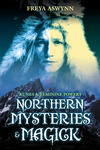Women's Empowerment Through Runes

At the time I write this, Northern Mysteries and Magick is nearly twelve years old. It took me at least five years to write the first incarnation, Leaves of Yggdrasil. This book initially had a marvelous reception, especially from women in Asatru. I'll never forget when I arrived at the campsite for a Troth Moot in the Bay area. There were a number of women all dressed up to the hilt in the most beautiful period costumes, all pointing the fingers at me and shouting in unison: "It's your fault!" That was an interesting reception. Since then, of course, a lot more people got involved in Asatru and some serious criticism was leveled last year on a Asatru mailing list that my work was not historical. I never claimed it was. Some people-well, men, basically-made their own assumptions.
Female Mysteries
So let's look at these issues and try to examine them. On the one hand, my book has proven invaluable to women who felt the urge to explore the Northern Mysteries, especially after Leaves was updated to Northern Mysteries and Magick, incorporating a more comprehensive section on Female mysteries. I am aware that apart from its appeal to Asa women it also had greatly influenced the Wiccan movement, and has often been sympathetically appreciated by those working in the Celtic Mysteries. And why not? Both are, of course, of native European origin. I more or less wrote the book in a haphazard fashion, my English was crap, and virtually every sentence was edited for grammar by my friend Jane Whitehead, who was my personal assistant during the process of the final drafting in 1986-87.
Long before that, however, I was compiling notes of Runic thoughts and associations which came to me during workshops, talks, and more often than not in the bath. Have you ever tried to have a bubble bath with a running tape recorder on the ledge—not to mention cats! Recent events in my private life have forced me to examine closely how this book came about, and if someone were ever to ask me; what are your sources? The honest answer is, dammit, there aren't any. The only other author on Runes whose book Futhark influenced me to a certain extent was Edred Thorsson, and I gave him full credit. Other than that, my sources are original and personal. When I had written my book, I never conceived of the idea that it might be worthy of a proper publisher. It was just my private hobby and I certainly did not consider myself a "professional author." I had a small private print run done out of my own pocket and hawked in and about central London in a shopping trolley on the underground.
Not for Fluff Bunnies
So what is so special about this book, apart from the crazy way it emerged into existence? It's one of the earliest book published on the Runes as more than a fortune telling system. Instead, it gives comprehensive interpretations of the meaning of runes. radically different from most other writings on the subject. These meanings are derived for the most part from European languages other than English, particularly Dutch. Where this book differs is that it doesn't promise you health, wealth, and the usual illusions of so-called happiness, but instead it tells you in no uncertain terms to how to use the Runes to manifest your will. How to solve problems and how to rectify injustices done to you. It kicks ass! It appeals to the warrior nature. Examples of workings are given sometimes in coded form so as to not contravene mundane laws, for those whoever can "read" between the lines, sections of this book could be described as a "lethal" weapon. This is not for fluff bunnies.
Dark Runes
Some parts of the book are decidedly "dark," especially the description of the Hagalaz Rune and the references to the darker side of the goddesses as deities of wyrd, death, sorcery in the North termed Seithr. Very useful stuff if you've got the balls to work with it. I admit with some embarrassment that some parts read like the rantings of a teenager in love with her god, but this too can serve as a role model how one may relate to one's chosen deity. Of course, I've grown up since, and middle-age cynicism is creeping up on me.
I am very pleased with the chapter on divination, even after all this time. It has proven over and over again its value, and many, many people since have adopted my systems. For example, the Nine Worlds of Yggdrasil lay out successfully in the personal practice of Runic Divination. Occasionally I have been given credit for this, which is always nice. Some of my Runic interpretations have been incorrectly assumed to be lore, but they were not. However, they are beginning to become established as lore, as I find more and more websites using them!
A Runic school has been founded based largely on my works, as well as others, and this is very gratifying. Finally, I am grateful to Odin who inspired me and Llewellyn who kept it in print all those years. Hopefully, many more people will derive benefit from this book. In the meantime, I've started on the sequel.
About Freya Aswynn
Related Products



is subject to certain Terms and Conditions